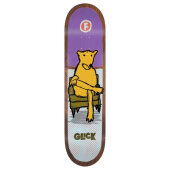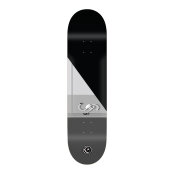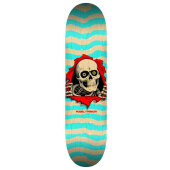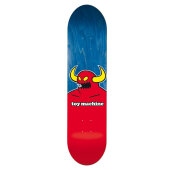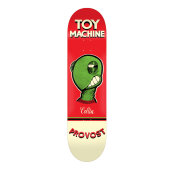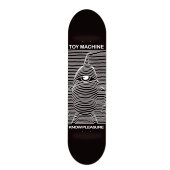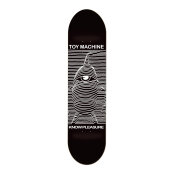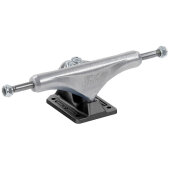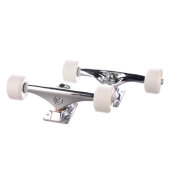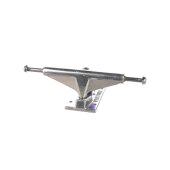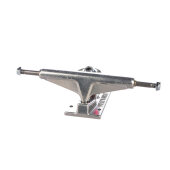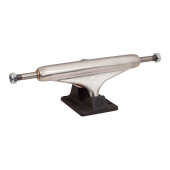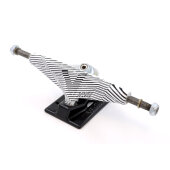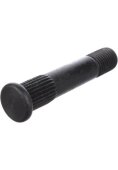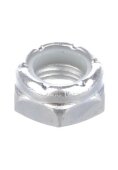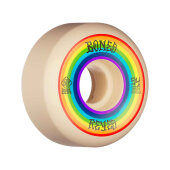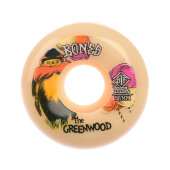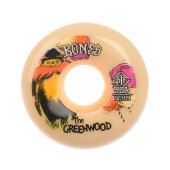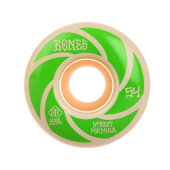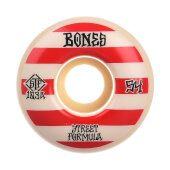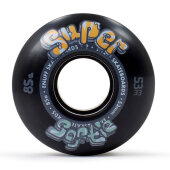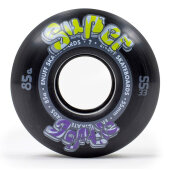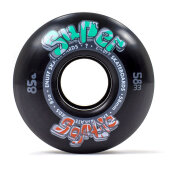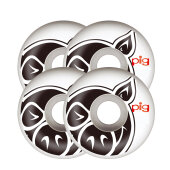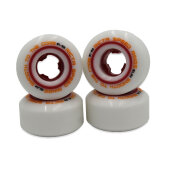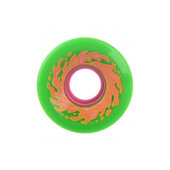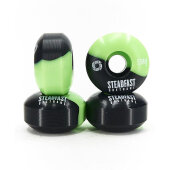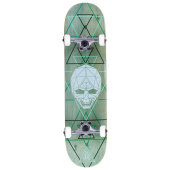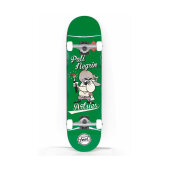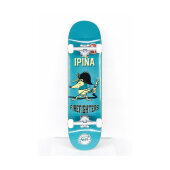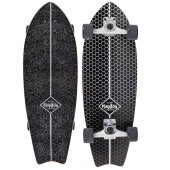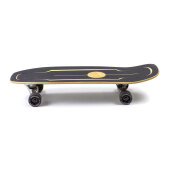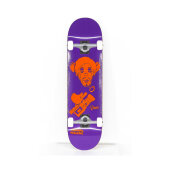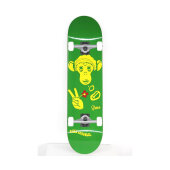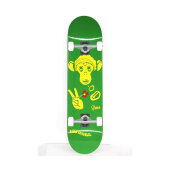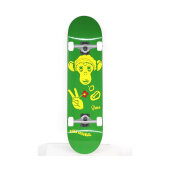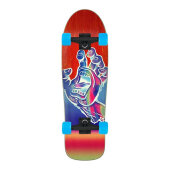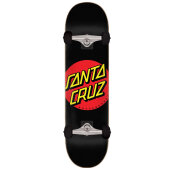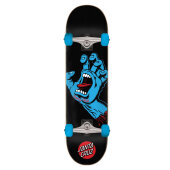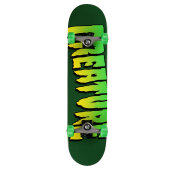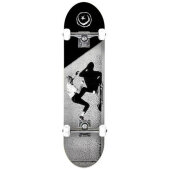Skateboards
SKATEBOARDS & ACCESSORIES - Your Skateboard at der-rollenshop.de
Whether you are a beginner or have been skateboarding for years, we offer a fine selection of skateboard completes, decks, trucks, wheels and bearings for skateboards. In our Skateboard FAQ, you can find out all the details about skateboarding, from deck size recommendations to wheel material. [read more]
SKATEBOARD BUYERS GUIDE at der-rollenshop.de

Which deck width and length is right for me?
Which truck is the right one for my deck size?
Which wheels do I need and which bearings are suitable?
The multitude of different skate articles and their possible combinations is often very confusing for beginners.
To help you make the right choice, we have clarified the most important questions in our Skateboard Buyers Guide.
Deck size recommendations
When choosing the right deck size, it is not only your body and shoe size that matter, your personal preferences and your type of skating also play a decisive role. However, the following table gives you a good guideline for your first board based on your body and shoe size.
DECK LENGTH
| BODY SIZE | DECK LENGTH |
| < 140 cm | 28"-30.5" |
| < 150 cm | 30.5"-31.5" |
| 150 - 175 cm | 31.5"-31.875" |
| 160 - 185 cm | 31.75"-32.00" |
| 170 - 195 cm | 31.875"-32.25" |
| 180 - 210cm | 32"-32.5" |
DECK WIDTH
| Shoe size | Deck width |
| 31,5 | < 7" - 7.25" |
| 32 | 7"-7.375" |
| 32.5 | 7.25"-7.5" |
| 34 | 7.375"-7.625" |
| 35 | 7.375"-7.75" |
| 36 | 7.5"-7.875" |
| 36.5 | 7.5"-7.875" |
| 37.5 | 7.625"-8" |
| 38 | 7.625"-8" |
| 38.5 | 7.75"-8" |
| 39 | 7.75"-8.125" |
| 40 | 7.875"-8.125" |
| 40.5 | 7.875"-8.25" |
| 41 | 8.00"-8.25" |
| 42 | 8.00"-8.25" |
| 42.5 | 8.00"-8.375" |
| 43 | 8.00"-8.375" |
| 44 | 8.125"-8.5" |
| 44.5 | 8.125"-8.5" |
| 45 | 8.25"-8.5" |
| 45.5 | 8.25"-8.625" |
| 46 | 8.375"-8.625" |
| 47.5 | 8.5"-8.625" |
| 48.5 | > 8.5" |
ATTENTION:
These values are approximate. Other board lengths and widths can be just as much fun.
In time you may find that other setups work better for you, but the values given will allow you to start skateboarding in the right way.
Skateboard-DECK FAQ
SIZE & CONSTRUCTION
Normaly, decks are between 28“ and 33“ (70-80cm) long.
Lengths are often given in the American unit inch. 1 INCH = 2.54cm
Decks are divided into three main areas: Nose, Tail and Wheelbase.
You can quickly find out where the front and back are with a little closer inspection. The nose of a classic deck is slightly wider and steeper than the tail. Basically,
the steeper the nose and tail, the more pop your board will have. An ollie, for example, is easier to execute this way. A flatter pitch of the nose and tail gives you a better board feel.
Most decks have a wheelbase length of 12“-15“.
The length of the wheelbase has a huge impact on skating behaviour. In summary, the shorter your deck, the more manoeuvrable it will be.
A longer deck provides more smoothness and stability.
THE CONCAVE
The CONCAVE describes how strong the longitudinal curvature of the deck is.
Skateboard decks are divided into three different CONCAVE levels: LOW-, MEDIUM- and HIGH-CONCAVE.
LOW CONCAVE:
Low curvature
More stable ride
More forgiving
More difficult to flip
MID CONCAVE:
Compromise between LOW and HIGH Concave
Most boards have a MID concave
More forgiving
HIGH CONCAVE:
More edge pressure
More manoeuvrable and better to flip
Not as forgiving compared to low or mid concave
More for advanced skaters
The higher the CONCAVE, the more pressure you can apply to the edges of the deck. A higher concave improves the flip and steering behaviour.
For complete beginners, a low or medium concave is best. Whether you prefer a board with less or more concave is a matter of time and trial and error and trying out different types of concave.
DECK SHAPES
The different disciplines of skating also have different demands on a deck. Over time, many different shapes have developed.
STREET / PARK
A classic street or park deck is shaped as a TWIN-TIP.
On skateboards, this shape is also called a popsicle shape. This means that the nose and tail of the deck are almost identical.
This makes the board easy to ride in both directions.
POOL / BOWL
Transition, "TRANNY-DECKS" are usually a little wider. Often the decks start at a width of 8.25“. In addition to the classic TWIN-TIP shape in wide, there are also decks that have special shapes and are reminiscent of the OLD-SCHOOL BOARDS from the 80s & 90s.
CRUISER
Cruisers are made to get from A to B or from your home to the park. Cruisers come in different lengths and widths. They are characterised by soft wheels, a good board feel and high manoeuvrability.
Disciplines
PARK & ALLROUND
In principle, all deck widths are suitable for the park or as an all-round board. The different widths naturally gives you a different riding feel and other characteristics.
Wider boards have more surface area and are easier to land and "catch" the board after tricks. On the other hand, wider decks are not as light and are less easy to flip compared to narrower boards.
Therefore, a slightly wider deck tends to make sense for beginners in order to learn the technique and skating itself safely.
Standard and mid axles are particularly suitable for your all-round setup. The wheels should have a size of 53-56mm and can be slightly softer.
STREET BOARDS
The optimal street deck is fast, light, manoeuvrable and robust. Due to the narrower dimensions, the boards can be flipped well and they are more manoeuvrable. That's why you should also have an eye on manoeuvrability when it comes to the axles. Mid or low axles are therefore best for your street setup. In order to save some weight, the axles are also available in extra light versions with hollow axle pins and kingpins. Smaller wheels make sense to get the maximum manoeuvrability out of the setup. Wheels from 50-53mm are the most common sizes in street skating. Often the wheels have a hardness from 100a upwards to withstand the heavy loads permanently. If your preferred spot has a very poor surface, it can also make sense to switch to slightly larger wheels. This reduces the risk of abrupt stops in case of cracks in the surface or stones on the track. The ball bearings for your wheels should also be as robust and resistant as possible. That's why stainless steel ball bearings are the most popular choice.
RAMP / BOWL / HALFPIPE
For ramps or bowls, wider decks are mainly used to make it easier to land the board during airs or tricks at the coping.
The wider footprint also gives you more safety at higher speeds.
The wheels are usually chosen in a slightly larger diameter of 53-56mm.
For more grip on the smooth concrete surface, it is an additional option to choose slightly softer wheels.
By combining them with high or mid axles, you can avoid wheelbites. Shockpads are also often fitted to handle hard landings better.
OUR DECKS
SKATEBOARD TRUCKS
Of course, every component of your board is important, but the TRUCKS have a significant impact on the performance of your board.
Therefore, it is even more important to find the right trucks for your deck. In the following, you will find all the important information and many useful tips for the right choice of your new skateboard truck.
The dimensions of the trucks are often given in the American unit inch. 1 INCH = 2.54cm
.
Some manufacturers also use millimetres for the dimensions of their trucks.
SKATEBOARD TRUCKS COMPONENTS
Skateboard trucks consist of the following components:
- Baseplate
- Hanger
- Axle pins & Axle nut
- Pivot & Pivot Cup
- Kingpin & Kingpin nut
- Bushings
- Top- & Bottomwasher
- Axle nut
- Speedrings
BASEPLATE
The baseplate is the part of the truck that is mounted to the skateboard deck with four mounting screws. All other axle components are attached to the baseplate.
HANGER
The hanger and baseplate are the two main components of a skateboard truck. The top of the hanger is the grindable part of the truck.
AXLE PINS & NUT
The axle pin is the part of the board where the wheels are mounted. The hanger is cast around the axle pins. They are usually made of steel, but there are also variants made of titanium. The mounted wheels are secured with the axle pin nut.
PIVOT & PIVOT CUP
The lower part of the hanger is called the pivot and is mounted in the pivot cup. The pivot is basically the joint or the pivot pin of the axle.
The pivot cup ensures that the pivot is well positioned and can rotate freely with as little play as possible.
KINGPIN & NUT
The kingpin is the screw that connects baseplate and hanger. The kingpin nut is used to secure it.
There are special axles where the kingpin and the axle pins are hollow to save weight.
BUSHINGS
The bushings are located between the baseplate and hanger and are mounted on the kinpin. They influence the steering behaviour of the skateboard axle through their hardness and shape. The bushings can be changed quickly and easily with a skate tool.
CHOOSING THE RIGHT SKATEBOARD TRUCK
When choosing the right skateboard trucks, the combination with your deck is crucial.
The truck width should always match the width of the deck. The skateboard trucks should not be significantly wider than the deck,
otherwise the board will be difficult to flip. If the trucks are wider than the deck, the board's centre of gravity will shift further out and the board will not be
as „flippable“.
.
It's fine if your deck is slightly wider than your truck. The manufacturers of the skateboard trucks mostly use the hanger width for their width specifications.
However, this information is rather confusing when it comes to finding the right truck. Therefore, it makes sense to orientate yourself on the complete width of the truck, i.e. the axle pin width.
In principle, the deck width is a good guideline for the axle width.
That means, axle pin width = deck width.
A deviation of +/-0.125“ is absolutely fine.
Example: Deck width 8.5“ = Axle pin width 8.375“ - 8.625“
LOW-, MID- or HIGH
Which truck height is the right one for your skate setup?
When choosing truck height, two points in are decisive: wheel size and body size.
The height of skateboard truck is measured from the baseplate to the centre of the axle pin and indicates how high the deck is above the ground.
Theoretically, a higher truck allows for a higher take-off, because by pushing the tail down, a higher truck has a steeper take-off angle.
However, this requires a lot of strength or long legs. Therefore, HIGH trucks are more recommended for tall skaters or for advanced skaters with a lot of strength.
Higher trucks can be skated with larger wheels without the risk of wheelbites.
However, a higher stance also results in a larger steering angle, which makes the skating behaviour more unstable.
Accordingly, it makes sense to use a LOW truck for kids, beginners or smaller skaters.
Mid trucks are a good compromise between LOW and HIGH axles and are best suited for an all-round setup.
LOW / 46-49mm
Lower centre of gravity
Stable handling
Danger of wheelbites
Especially for landings and soft bushings
Recommendation: smaller wheels up to 52mm
Mount shock or riser pads between trucks and deck
MID / 50 - 53mm
Compromise between low and high axes
Ideally suited for an all-round setup
Most boards are sold with medium-high axles, as they are the best compromise between low and HIGH axles
HIGH / 53.5-58mm
Theoretically More Pop
Requires more strength
Steeper angle on take-off
No risk of wheelbites with wheels up to 56mm
Shock/riser pads should be mounted, when wheels larger than 57mm.
Higher stance = larger steering angle = more unstable driving behaviour
OUR TRUCKS
Skateboard WHEELS FAQ
What material are skateboard wheels made of?What is the difference between soft and hard wheels?
Which wheel size is the right one for me?
Questions about questions, we help, let’s go!
THE MATERIAL
Skateboard wheels are made of polyurethane, or PU for short. Polyurethane is a plastic that can be produced in different hardnesses, but not all PU is the same. There are different manufacturer-specific mixtures that provide for different properties of the wheel. These are mainly speed, smoothness, slideability and durability. In terms of durability, we are talking about the wear and tear of the wheel and how flatspot resistant they are. Flatspots occur as soon as you slide with your board, i.e. when you position your board perpendicular to the direction of travel. This is part of skating when doing tricks. This of course puts extreme stress on the wheels and there is a risk of grinding a flat spot into the wheel. The result is a square wheel, which of course no longer runs smoothly. Especially with softer wheels, the risk of a flat spot is even greater.
THE CONSTRUCTION
There are also different construction types when it come to skateboard wheels. A distinction is made between CORE and STANDARD wheels. CORE wheels have a separate plastic core made of harder plastic than the surrounding PU. On the one hand, this saves weight, on the other hand, core wheels have a more precise bearing seat than standard wheels. This results in better freewheeling compared to standard wheels.
THE SIZE
The size of the skateboard wheels is given in millimetres and describes the diameter of the wheel. As a rule, skateboard wheels are between 50mm and 59mm.
Anything larger is more likely to be used on cruisers or longboards. Smaller wheels are easier to accelerate and more manoeuvrable.
Larger wheels are more comfortable and have a higher top speed. In addition, larger wheels do not lock as quickly.
However, the choice of the right wheel size depends above all on the intended use.
Our recommendation:
STREET-SKATING 50-53mm
PARK-SKATING 53-56mm
VERT-SKATING 56-59mm
In addition, the wheels must of course fit your board without causing annoying and dangerous wheelbites.
A wheelbite is when the wheel touches the deck and the board comes to an abrupt stop. If you choose wheels that are too big, there is simply not enough space between the wheel
and the deck when turning in. For larger wheels, either higher trucks or riser pads are needed. This also increases the overall standing height.
As a result, jumping off with the board becomes more difficult for smaller and normal-sized skaters, also pushing becomes more difficult.
LOW trucks maximum 52mm wheel size
MEDIUM trucks maximum 52-56mm wheel size
HIGH trucks maximum 59mm wheel size
CONTACT PATCH
With skateboard wheels, there is another decisive factor to consider when choosing wheels.
The running surface, also called contact patch, describes the surface that has permanent contact with the ground.
A basic distinction is made between Basic and Slim wheels. The Basic wheels have a contact surface of 18-20mm, while the Slim wheels have a contact surface of 15-17mm.
The smaller contact area reduces friction when skating and sliding. Slim wheels are particularly suitable for technical skating.
Basic wheels are a good compromise, have better grip and are more comfortable to skate on.
THE HARDNESS
The wheel hardness is measured in durometers and indicated in the unit of measurement A. The maximum, hardest value of the A scale is 100. The lower the A number, the softer the wheel. Since the A scale goes up to a maximum of 100 and the measuring method becomes rather imprecise in the upper range, some manufacturers, especially BONES WHEELS, use the B scale. In this case, the measured values are approx. 20 points below the A scale. These wheels are harder than the wheels on the A scale. A Bones wheel with a hardness of 84B corresponds to about 104A. An 82B hardness corresponds to 102A.HARDNESS OVERVIEW - SKATEBOARD WHEELS
SOFT (78A-92A)
Comfortable, especially on rough surfaces
Really grippy
Slides are more difficult
Rapid wear
A little slower
MIDDLE HARD 93A-95A
Still grippy
Good compromise for spots with rough surfaces
HARD 95-99A
Perfect all-round hardness
Sufficient grip
Good roll & speed
EVEN HARDER 99A-101A / 83B-84B
Easy to slide
Good acceleration
High final speed
Little grip and comfort
OUR SKATEBOARD WHEELS
OUR COMPLETE BOARDS
Of course, there are many very good boards that are already super tuned and come fully assembled. All you have to do is unpack and start skating!
CONTACT
EXPERT ADVICE FROM SKATERS FOR SKATERS
With the large number of skate products, questions may occur. Of course, we are also happy to help you by e-mail or telephone.
Mail: info@der-rollenshop.de
Phone: Request a callback
Are you interested in our skate experts?
Check out our About Us.





















